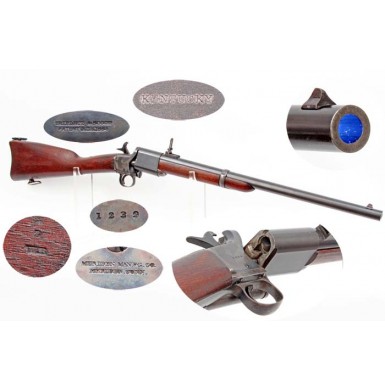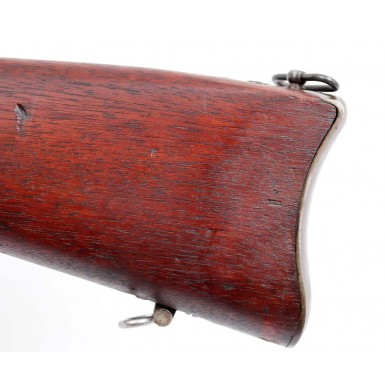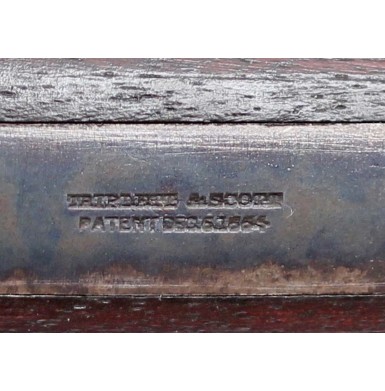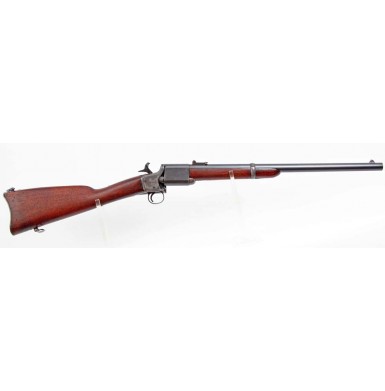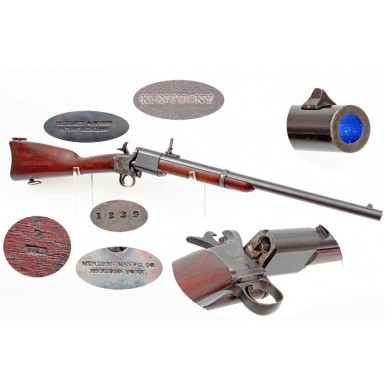Minty Triplett & Scott Kentucky Carbine - Really Outstanding
- Product Code: FLA-2786-SOLD
- Availability: Out Of Stock
-
$1.00
This is a EXCELLENT+ to NEAR MINT condition example of the Triplett & Scott Carbine, produced under contact for the state of Kentucky in 1865. The story of the Triplett & Scott carbines and rifles is somewhat convoluted, and at times confusing. The design was the brainchild of Louis (alternately Lewis) Triplett of Adair County, KY. Triplett received US patent 45,361 for a “magazine rifle” on December 6, 1864. While Triplett appears to have had no manufacturing experience or capability, he must have had friends or contacts in Louisville that put him in touch with W.T. Scott. Little is known of Scott, but at the very least he had some level of political influence, as Governor Bramlette of Kentucky ordered the state adjutant general to contract with Scott for the production of 5,000 long arms of 56-50 Spencer caliber for issue to the Kentucky State Home Guard. The guard had been charged with the protection of General W.T. Sherman’s supply lines that ran through the state. These supply lines were being harassed by Confederate sympathizers and guerillas. Scott could obtain no arms from any of the usual sources or arms manufacturers, and subsequently contacted with the Meriden Manufacturing Company of Meriden, CT to produce the Triplett design. On January 2, 1865 he contracted for 3,000 Triplett & Scott rifles with 30” barrels and 2,000 Triplett & Scott carbines with 22” barrels. The Meriden Manufacturing Company was a partnership between Charles & Edmund Parker and William & George Miller. Parker was a successful manufacturer of coffee grinders and miscellaneous hardware items, which he had been producing in his factory since the mid-1830s. With the coming of the American Civil War, Parker put his production and manufacturing knowledge to use producing gun locks, and other iron furniture for the M-1861 rifle musket. His parts business grew into a partnership with Gamaliel F. Snow, and a Mr. Brooks that subsequently became Parker, Snow, Brooks & Co, and eventually Parker, Snow & Co. This company is better known to arms collectors today by the lock marking: Parkers’ Snow & Co. that appeared on their arms. The firm produced some 15,000 US M-1861 Rifle Muskets in 1864 under contract for the Ordnance Department, and they appear to have manufactured at least some of the rifle muskets delivered under James Mulholland’s contract in 1863. After the conclusion of the Parker, Snow contacts, the Parker Brothers formed the Meriden Manufacturing Company with the Millers and went into production of the Triplett & Scott carbines. The guns were delivered too late for use during the war, and the majority remained in Kentucky state inventory until 1870. The State of Kentucky applied to the Federal Government under the Indemnification Act of 1861 for reimbursement of the funds spent on the Triplett & Scott guns. After receiving payment in 1870, the arms were transferred to the Federal Arsenal in New York, via Indianapolis. When the guns arrived in New York on October 21, 1871 they included 1,900 “New” 22” carbines and 2,810 “New” 30” rifles. Also delivered were 50 rifles “cleaned & repaired”, as well as 93 carbines and 133 rifles classified as “unserviceable”. This accounts for 4,986 of the 5,000 arms. In June of 1901 the New York Arsenal sold 4,705 Triplett & Scott patent arms to Kirkland Brothers in three lots; 2,349 were sold at .25 cents each, 545 at .10 cents each and 1,811 at .20 cents each. Marcellus Hartley & Company purchased an additional 72 of the guns at prices varying between .21 cents and .30 cents each. What happened to the other 209 Triplett & Scott guns that were in storage at the arsenal is not known, nor is the fate of the 14 guns that never made it to New York in the first place. Today the 30” rifle is encountered far more often than the 22” carbine, causing Norm Flayderman to note in his section on the Triplett & Scott that the carbines are “quite scarce and will bring approximately 20% premium over the values listed.” The Meriden Manufacturing Company only ventured into one more arms manufacturing endeavor, the alteration of US M-1861 rifle muskets to breechloaders by the “Miller Conversion”, based upon Miller’s US Patent #47,902. After the dissolution of the firm, Charles Parker, along with his sons Dexter and Wilbur formed the famous Parker Brothers Company, the makers of the finest and most famous American double-barrel sporting shotguns ever produced.
The Triplett & Scott carbine was a unique and almost Rube Goldberg patent breech loading long arm, produced in an era where odd ball patent firearms appeared and disappeared on the market with great rapidity. The gun was chambered for the Spencer 56-50 rimfire cartridge (better known as the .50 Government Rimfire), a round the US Ordnance Department had created as an improvement upon the original 56-52 Spencer cartridge in an attempt to standardize the rimfire metallic cartridge ammunition that was being issued for many patent carbines in military service towards the end of the American Civil War. That cartridge would remain in service on the frontier through the late 19th century, although mostly as a secondary military cartridge and with the civilian population. The Triplett & Scott was a truly strange two-piece design, with the breech face, firing controls, magazine and buttstock as the rear most assembly, attached to the firing chamber, barrel and forend assembly by a pivoting joint. The gun used a seven round tubular magazine in the buttstock, similar the Spencer, but it was not removable. The magazine tube was situated off center to the left, along the toe line of the stock. This design left almost no wood in the buttstock over the magazine tube and left the wrist very weak. As a result almost every Triplett & Scott has a severe crack, and often wood loss, in that region. It was simply a horrible design and quite weak in that area. To operate the action of the gun the hammer was placed on half cock, and a thumb release catch was depressed on the rear of the receiver. This allowed the shooter to rotate the forward half of the receiver to the right (clockwise) and as the forward portion rotated an automatic ejector would extract the spent cartridge case from the receiver, dumping it on the ground. As the forward portion of the receiver was rotated further around, it pushed a spring-loaded door, which covered the magazine tube, open. This allowed a cartridge to be fed into the firing chamber. Rotating the action back to the left (counter clockwise) closed and locked the action, and cocking the hammer fully made the gun ready for firing. While this seems like a convoluted and complicated system, it did work and with training a solider could operate the gun with some efficiency. The primary drawback to this system versus a lever action repeater was that the gun had to be taken from the shoulder to operate it and then remounted and the sights reacquired. A lever action rifle could be operated at the shoulder while the sights remained on target. The carbine and rifle both featured a flip up, adjustable, long-range rear sight and a pair of opposed sling swivels mounted on the top and the bottom of the buttstock. The guns were produced with blued barrels, magazine tubes, and small parts, and case hardened receivers, hammers, triggerguards and buttplates.
This particular Triplett & Scott Carbine is in EXCELLENT+ to NEAR MINT condition. The gun is simply outstanding. The wood in particular is the best I have ever encountered on these guns. The action retains about 95%+ of its original, vivid case hardened finish, with brilliant blue, purple, plum-brown and straw tones. The receiver is crisp metal, free of any pitting or pinpricking. The rear portion of the receiver is marked with the serial number 1239 on the obverse and MERIDEN MANUFACTURING. CO / MERIDEN. CONN on the reverse. The forward portion of the reverse receiver is marked in a single line: KENTUCKY. The barrel tang is marked in two lines: TRIPLETT & SCOTT / PATENT DEC 6, 1864. The forward portion of the receiver retains about 90%+ of its original blue, with the only loss due to fading from age and a couple of very minor surface scratches. The areas that have faded have mixed with a lightly oxidized plum-brown patina, and the fading is only visible under the most sever lighting. The barrel retains about 92+% of its original blue, and shows only some very minor fading, a few minor handling marks and a couple of minor surface scratches. The minor fading is due to age, and the fading blue has mixed with an oxidized plum-brown patina. The barrel metal is similar to the receiver, mostly completely smooth and crisp with absolutely no pitting or pinpricking present. The bore of the carbine rates about MINT. It absolutely brilliant, with only some scattered areas of old accumulated dust and lint along its length. The bore retains crisp, factory-new rifling along its entire length. The action of the carbine functions perfectly and the gun is mechanically excellent. The receiver release functions correctly and the forward portion of the action rotates smoothly as it should. The automatic extractor functions correctly and the magazine cover opens and closes as it should. The action locks back into position tightly and the hammer functions well on both half and full cock positions. The casehardened buttplate has a lightly mottled yellowish-brown color mixed with a smoky patina due to fading. The hammer has a dark, smoky gray patina with some traces of mottling, while the triggerguard and tang retain about 95%+ of their vivid case hardened coloring. The original long-range rear sight is in place on the barrel, forward of the receiver and the original front sight is in place near the muzzle as well. Both of the original sling swivels are in place on the buttstock, one on the top and one on the bottom. The gun remains crisp throughout with excellent, sharp edged and extremely fine fit between metal and wood parts. The stock of the carbine is in about EXCELLENT to NEAR MINT condition. The wood is extremely crisp throughout and had not been sanded. Typically these carbine show significant damage and cracking in the stock along the magazine tube and wrist area. This gun shows no such cracks or breaks, and the stock is truly magnificent. The rear of the reverse buttstock is clearly marked with a crisp Z / W.B inspectors mark. These marks are typically worn away and illegible on Triplett & Scott arms. The both the buttstock and forend of the gun are solid and free of any breaks, cracks or repairs. Both the buttstock and the forend show only some minor bumps and dings from handling and storage, and possibly from post war use.
Overall this is an absolutely outstanding example of a relatively scarce Civil War related carbine. With only 2,000 produced, the guns are not common on the collector market today. This one is truly about the best Triplett & Scott carbine that I have ever seen. It has a really wonderful stock that is completely free of the typical Triplett & Scott problems, and the complicated action and mechanism work exactly as they should. These guns are a very interesting example of some of the strange patent arms developed during the Civil War, and their Kentucky markings and association make them interesting as well. Probably the most intriguing part of the story is that these guns were the predecessors to some of the finest shotguns ever made, by the legendary Parker Brothers Company. No matter what part of the story is most intriguing to you, this is one of those guns that has a place in any advanced US military carbine collection, especially one that concentrates on patent breechloaders and state purchases. This is truly an investment grade example of a rare Civil War contract carbine that would truly be almost impossible to upgrade.
SOLDTags: Minty, Triplett, Scott, Kentucky, Carbine, Really, Outstanding

